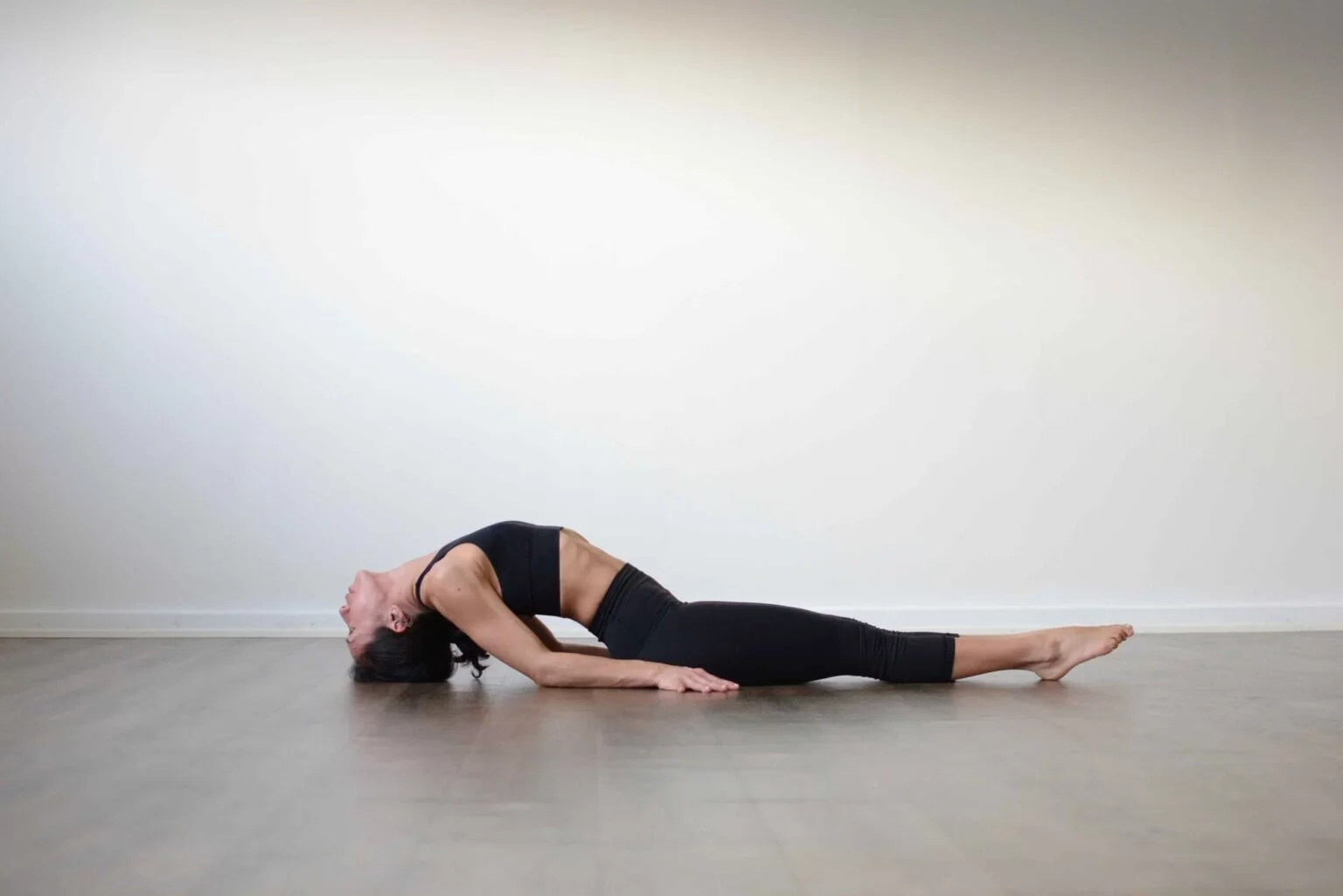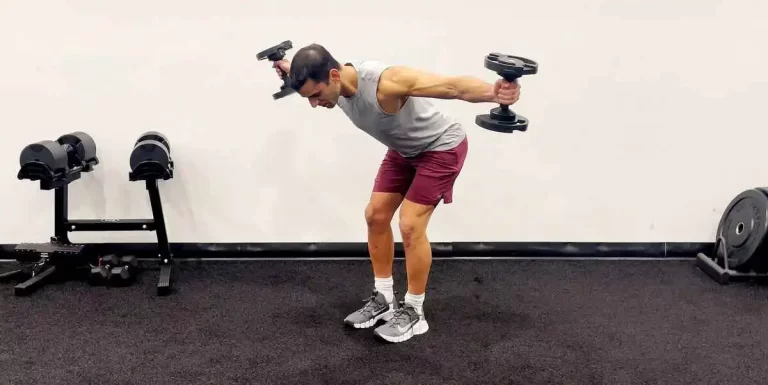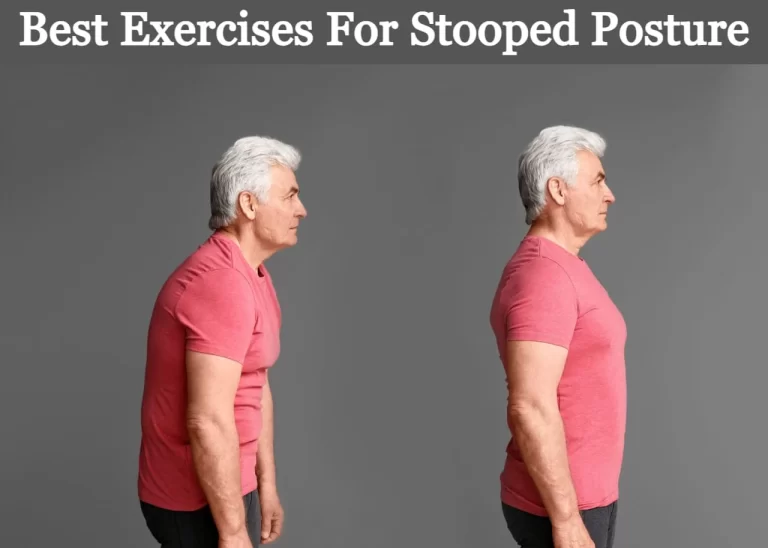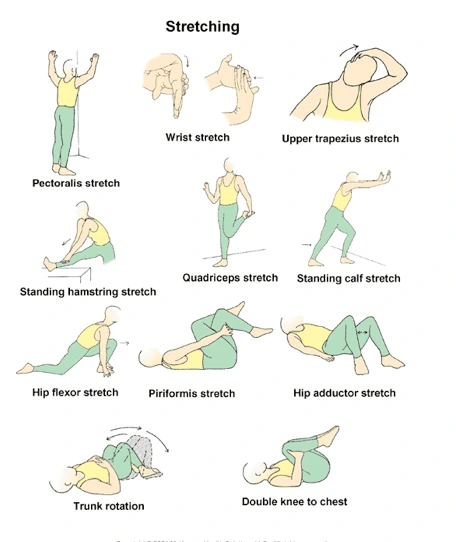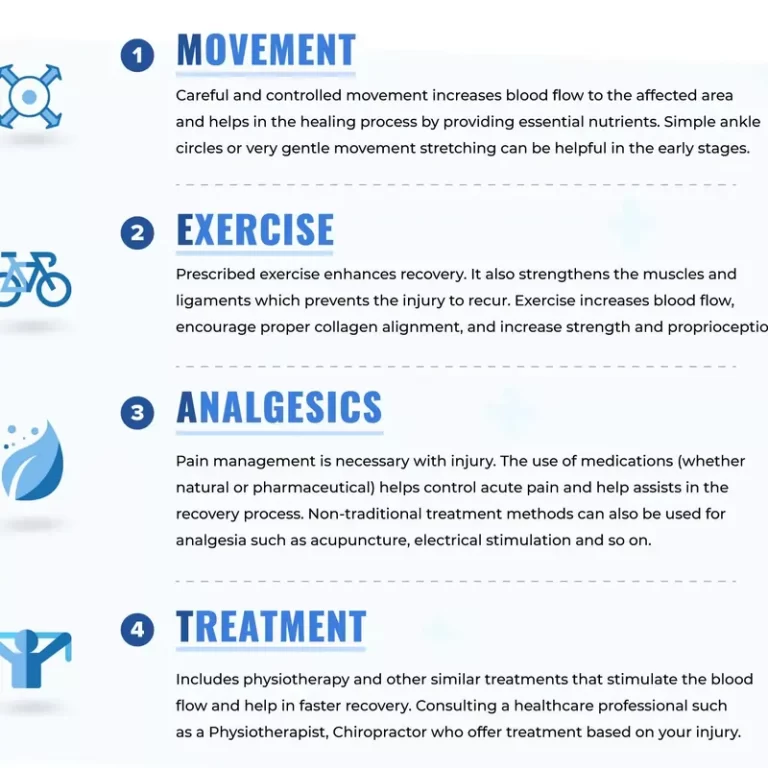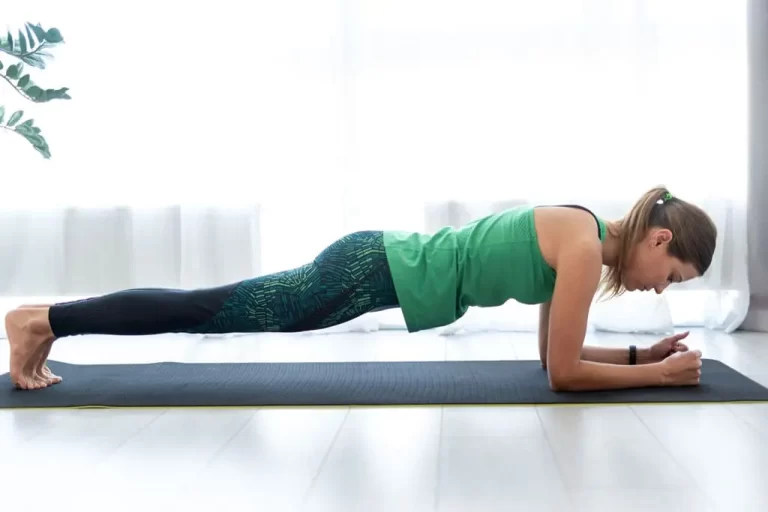Fish pose (Matsyasana)
Fish Pose, or Matsyasana, is a classic yoga posture known for its heart-opening and chest-expanding benefits. Derived from the Sanskrit words “Matsya” (fish) and “asana” (pose), this posture is often referred to as the “destroyer of all diseases” in traditional yogic texts.
By stretching the throat, chest, and abdomen while stimulating the spine, Matsyasana is celebrated for enhancing flexibility, relieving tension, and promoting relaxation. It is an excellent pose for counteracting the effects of prolonged sitting or slouching, helping to restore balance and vitality to the body and mind.
What Is Fish Pose?
The “Fish pose,” or “Matsyasana,” is a back-bending, reclining yoga exercise that stretches the throat, chest, shoulders, and abdomen. Lying on your back and flexing while bearing your weight on your hips and forearms is known as the chest-opening stance.
Fish posture is used in sequences in Iyengar, Hatha, Vinyasa, and Yin yoga as a counter-pose to the shoulder stand (Sarvangasana), which exercises similar muscles. The neck-constricting position stretches the hip flexors, intercostals (muscles around the rib cage), neck, and back muscles, promoting spinal flexibility and respiratory health while also reducing fatigue and anxiety.
Which muscles are used in the fish pose?
- Erector Spinae
- Quadratus Lumborum
- Neck Flexors
- Pectoralis Major and Minor
- Abdominal Muscles
- Hip Flexors
- Intercostal Muscles
What are the Health Benefits of fish pose?
When performed thoughtfully and in synchronization with deep, elongated breathing, the fish position offers numerous benefits.
- Reduces fatigue and anxiety: Tension in the shoulder region is released and energy levels are raised by this profound opening of the heart zone.
- Can relieve constipation and menstrual cramps: The abdominal stretch offered by Fish Pose can aid in massaging the internal organs responsible for these two illnesses.
- Promotes respiratory health: The lungs are opened by the chest’s expansion, which also promotes deep breathing into the organs’ bottoms.
- Improves posture and flexibility in the spine: The shoulder rounding brought on by hunching forward when sitting is reversed by the stretch that the fish position offers to the neck and shoulders.
What are the Preparatory poses for Fish pose?
Matsyasana is frequently performed as a counterposition following Shoulderstand, even though Sarvangasana is not strictly a preliminary pose. To fully master Matsya asanas, it may be necessary to practice certain positions, even though the fish pose is not as challenging. Additional preparations for this role could consist of:
- Baddha Konasana or the Butterfly Position
- Bhujangasana or the Cobra Position
- Virasana or the Hero Position
- Salabhasana or the Locust Position
- Dhanurasana or the Bow Position
- Setu Bandha Sarvangasana or the Bridge Position
- Supta Virasana or the Reclining Hero’s Position
- Surya Namaskar or Sun Salutation
- Pavan Muktasana, also known as the Head-Up Wind Release Position
- Virasana
How to Perform Fish Pose?
- On your back, lie flat. Hold your feet together.
- Put your hands beneath your thighs, close to your buttocks.
- Weight down on your elbows to raise your chest while keeping your forearms firmly on the floor.
- Lower your head back till it hits the floor once your chest is off the ground.
- Make sure the weight of your body is supported by your elbows rather than your head.
- Now that your body is in an arch, take a steady breath. Maintain the posture for approximately one minute.
- To release the stance, straighten your back and lift your head off the floor.
- Lower your torso to the floor now. Let your body relax.
Fish pose video
What are Follow-up poses for Fish pose?
- Camel Position (Ustrasana)
- Elbows in the Supta Virasana (Reclined Hero Position)
- Gomukhasana
- Setu Bandha Sarvangasana
- Supta Virasana
- Ustrasana
- Virasana
What are the beginner tips in fish pose?
- Starters can begin by lying on their back with their face up and folding their legs if they have trouble assuming this position. In this position, starters can put strain on their necks. If you experience pain in your throat or neck, drop your chest slightly to the floor or tuck a thickly folded blanket under the back of your head.
- Don’t forget to lift your chest before lowering your head.
- You should have a soft throat. Don’t twist your neck back like a Pez dispenser. Instead, you ought to be able to communicate in the role. Say your name.
- Avoid turning your head when you are in the full expression of this pose.
- The more you press into your forearms when applying them to the ground, the higher your chest will rise.
- Maintaining an active and extended leg length will assist reduce the strain on your lower back.
- You should back off and leave the position early if you ever feel lightheaded or out of breath.
- Ensure that your head is above your head. Neck pain or injury may result from improper head positioning.
- Because changing this position can lead your joints all over your body to become disconnected, consider doing it during pregnancy or right after giving birth. Because of this, the majority of yoga instructors advise not to bear weight on your head during this period.
What is the Breath Awareness in fish pose?
- Inspire and Expire: Extend your legs in the Savasana (Corpse Position) and let your body relax.
- Inspire: Raise the lower back slightly by placing the palms beneath it and twisting the elbows.
- Expire: Expire by twisting your elbows.
- Inspire: As you guide the head and shoulders upward, raise your upper body off the ground.
- Exhale: As you exhale, slowly raise and lower your head, rest the top of your head on the floor, and fully expand your chest.
- Inspire and Expire: Start with a calm inspiration and expiration while maintaining this yoga pose. As you expire, conduct your head lower down and directly out from your chest.
- Inspire: Take a slow breath, raise your head, and then let go of your shoulders.
- Expire: Exhale, stretch your entire body back down to the floor or mat, and take a few deep breaths to help you relax.
Fish Pose Modifications
Fish position can be altered in a variety of ways to either increase the stretch’s intensity or provide a little more comfort and support as you transition into this reclining backbend:
- Lotus legs. The conventional form of this position starts with entering the Padmasana, or lotus pose, according to B.K.S. Iyengar’s Light on Yoga. After synchronizing the legs, arms, and hips, the performer returns to the fish posture and understands the opposing elbows behind the head.
- Hands underneath the buttocks. To increase the backbend’s depth and provide support at the same time, drop your palms down beneath your buttocks.
- Use a block or two. To deepen the backbend and raise the chest while supporting the spine and letting specific muscle groups relax into the support of the blocks, you can position a yoga Block beneath your midback or between your shoulder blades.
- Folded blanket underneath the head. Place a folded blanket beneath the back of your head for comfort and support.
- Suspend your legs and arms. Only expert practitioners should use this modification. Try raising your arms and legs in the air while in a fish position if you feel anchored in your hips and are being guided by a qualified yoga instructor. Instead of putting most of your weight on your head, keep it mostly on your hips.
What are the Types of Fish pose?
There are 3 types of Matsyasana.
- Vajra Matsyasana (Thunderbolt Fish Position)
- Vajra Padma Matsyasana (Half Thunderbolt Fish Position)
- Ardha Matsyasana is half-Lord of the Fishes.
Vajra Matsyasana
What is Vajra Matsyasana?
Another name for Vajra Matsyasana is Thunderbolt Fish Position.
How to Perform Vajra Matsyasana?
While seated, guide the foot to the left buttock by twisting your left leg. Point your right foot next to your left foot while twisting your right leg.
Onto the toes, shift the weight forward. In a version of Vajrayana, sit with your heels connected and bring your knees to the floor with your toes together and your heels apart.
Lean back slowly as you inhale and exhale, placing the top of your head on the floor and gradually using your elbows for support.
Keep the hands on their various thighs or hold their feet. Adjust your posture, and take regular breaths, The pelvis, abdomen, chest, and throat are all stretched, while the back is arched.
Though some detachment may be there if it is uncomfortable, the thighs should be together.
During the pose, keep your hands on the floor and use your elbows to support your upper body.
Transfer your weight onto your toes by raising your knees. Raise the left leg straight.
Return to the sitting position by adjusting the right leg and lowering the buttocks to the floor.
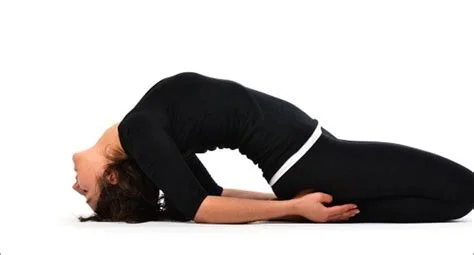
Vajra Padma Matsyasana
What is Vajra Padma Matsyasana?
Padma Vajra The Half Thunderbolt Fish Position is the name given to Matsyasana.
How to Perform Vajra Padma Matsyasana?
On your back, lie down.
In Vajrasana, position the leg’s heel outside the buttocks.
Elevate the chest far enough off the ground with the aid of the elbows so that the head’s crown rests on it.
Arch the back, use the elbows for support and lower the top of the head into the floor.
Using your hands, firmly grasp the feet.
Exhale slowly between the mouths after taking a deep breath over the nose.
Hold the position for one minute. Return to the starting position.
constant on both sides.
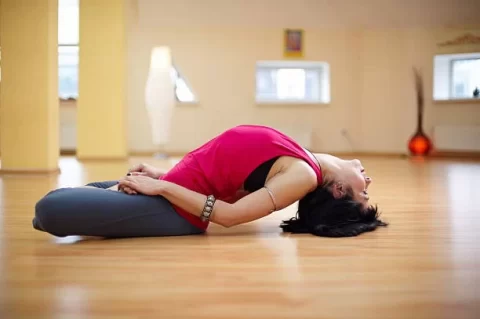
Ardha Matsyasana is half-Lord of the Fishes
What is Ardha Matsyasana?
A twisting seated pose of intermediate difficulty is the Half Lord of the Fishes Pose (Ardha Matsyendrasana). The Sanskrit terms Ardha, which means half, Matsya, which means fish, and Asana, which means position or posture, are the origin of the English phrase Half Lord of the Fishes Position. Other variations of this yoga pose include Vakrasana (meaning twist) and the Half Spinal Twist Position. There are numerous versions of this yoga pose, which typically manifests as a seated spinal twist. With the thighs lying on top of one another and the arms supporting the torso, the spine in this yoga pose reaches its greatest twist at the upper back.
Ardha Matsyendrasana, commonly known as the Half Lord of the Fishes Position or the Seated Twist Position, is a powerful, healing twist. The position causes your entire body to twist, which enhances spinal mobility, aids with digestion, and increases circulation.
After being warmed up and animated in earlier postures, it’s okay for me to feel like my entire body is starting to wring out. Ahead, when I was younger. I even understand what yoga is. During soccer drills, I would run around the area and then perform this pose. It has always served as a source of strength for me.
The fact that yoga places you in positions you wouldn’t typically do during your day is one of its significant features. Approach locations where you didn’t even know you were harboring tension by acting differently. Deep twists like Half Lord of the Fishes undoubtedly exhibit this.
How to Perform Ardha Matsyasana?
Raise the right leg slightly and place it near the right hip, tucking it deeply under the right seated bone, while twisting the left knee and directing the left foot under the right thigh.
Position the right foot above the left thigh and lay it on the ground outside the left hip while maintaining the right knee near your upper torso.
Breathe deeply, bend your upper body to the right, conduct your right hand, and twist it to land on the earth immediately beyond you.
The palm should be positioned toward your lower back, behind you, and the bend should be more from the inside of your right leg.
Grab the right foot with the left arm while positioning the outer elbow toward the outside of the right knee. Pull your inner right thigh and anterior torso together.
Once expiration is complete, moderately place the right hand on the hips in an attempt to hold the left side of the lower back while twisting the torso more to the right.
Make sure that the shoulders and neck are in alignment when bending the body slowly and simply. The face, shoulders, and chest are all perfectly adjusted here.
Raise somewhat further through the sternum with each inspiration, bending deeper with the aid of the right fingers pushed deep into the left upper thighs. And with each expiry, twist a bit further.
Since preserving bodily balance is the major goal of this position, make sure to distribute evenly. The spine twists uniformly along its whole length.
To ensure that the body is properly balanced at the hips, make sure that both sit bones are on the ground.
To ensure that the body is properly balanced at the hips, make sure that both sit bones are on the ground.
Continue in this posture for as long as it feels comfortable by twisting your right leg and then taking your left foot over and twisting to the left side.
What are the Precautions and Contraindications for the fish pose?
Precautions and Contraindications for Fish Pose (Matsyasana)
Despite the many advantages of Fish Pose, it’s crucial to understand some safety measures and contraindications:
Precautions:
- Neck and Back Issues: People with back or neck ailments, particularly those with cervical spondylitis, should refrain from using this position or seek medical advice before trying it.
- High Blood Pressure: This position should be done carefully and under the supervision of a certified yoga instructor for people with high blood pressure.
- Headaches and Migraines: This pose may make headaches and migraines worse, therefore anyone prone to them should avoid them.
- Pregnancy: This pose can place too much strain on the spine and abdomen, thus pregnant women should avoid it.
- Menstruation: This pose can be physically taxing, therefore women who are menstruating might want to avoid it.
Contraindications:
- Severe Neck or Back Injuries: This stance should be avoided at all costs by those who have serious back or neck ailments.
- High or Low Blood Pressure: This stance is not recommended for anyone with uncontrolled high or low blood pressure.
- Heart Conditions: People who have heart issues should either stay out of this stance or speak with a doctor.
- Glaucoma: This stance should be avoided by those who have glaucoma since it can raise intraocular pressure.
What are the Common Mistakes in fish pose?
- To avoid these errors and get the most out of this role, evaluate your performance.
- Too Much Pressure on Head: you raise your upper body and relieve pressure on your head, be sure you ground into your forearms, heels, and unusable thighs.
- and neck is secure and helpful.
- Straining the Neck: Maintain a continuous arch between your neck and back. Imagine the center of your top resting on the floor rather than letting your forehead relax.
FAQs
What are the benefits of the fish pose?
eases the strain on your shoulders, throat, and neck. tones and stretches your abdominal muscles and the front of your neck.
How long to hold a fish pose?
If at all feasible, maintain the position for three minutes. Let go of the stance gently. To protect your neck, raise your head first, then slowly, inch by inch, lower it to the ground.
Is fish pose safe?
Although most people believe supported fish pose to be safe and accessible, there are a few things to be aware of: 1. Pre-existing Spinal or Neck ailments: Caution should be used when performing supported fish posture by anyone who has spinal or neck ailments.
What to do after a fish pose?
To release yourself from Matsyasana (Fish Pose), lower your head and chest to the floor, raise your head gently, and then bring your hands back along your body’s sides. Make sure the lower spine is near the floor and the head is completely at rest. Relax and breathe deeply in Savasana (Corpse Pose).
References:
- Fish Pose Yoga (Matsyasana) | Yoga Sequences, Benefits, Variations, and Sanskrit Pronunciation | Tummee.com. (2018, May 11). Tummee.com. https://www.tummee.com/yoga-poses/fish-pose
- Sorathiya, D. (2023, September 5). Matsyasana – Health Benefits, How to do?- Variations. Mobile Physiotherapy Clinic. https://mobilephysiotherapyclinic.in/matsyasana-yoga-pose/
- Vastralphysiotherapyclinic. (2024, February 7). Matsyasana – Yoga Position. Mobility Physiotherapy Clinic. https://mobilephysiotherapyclinic.net/matsyasana/

